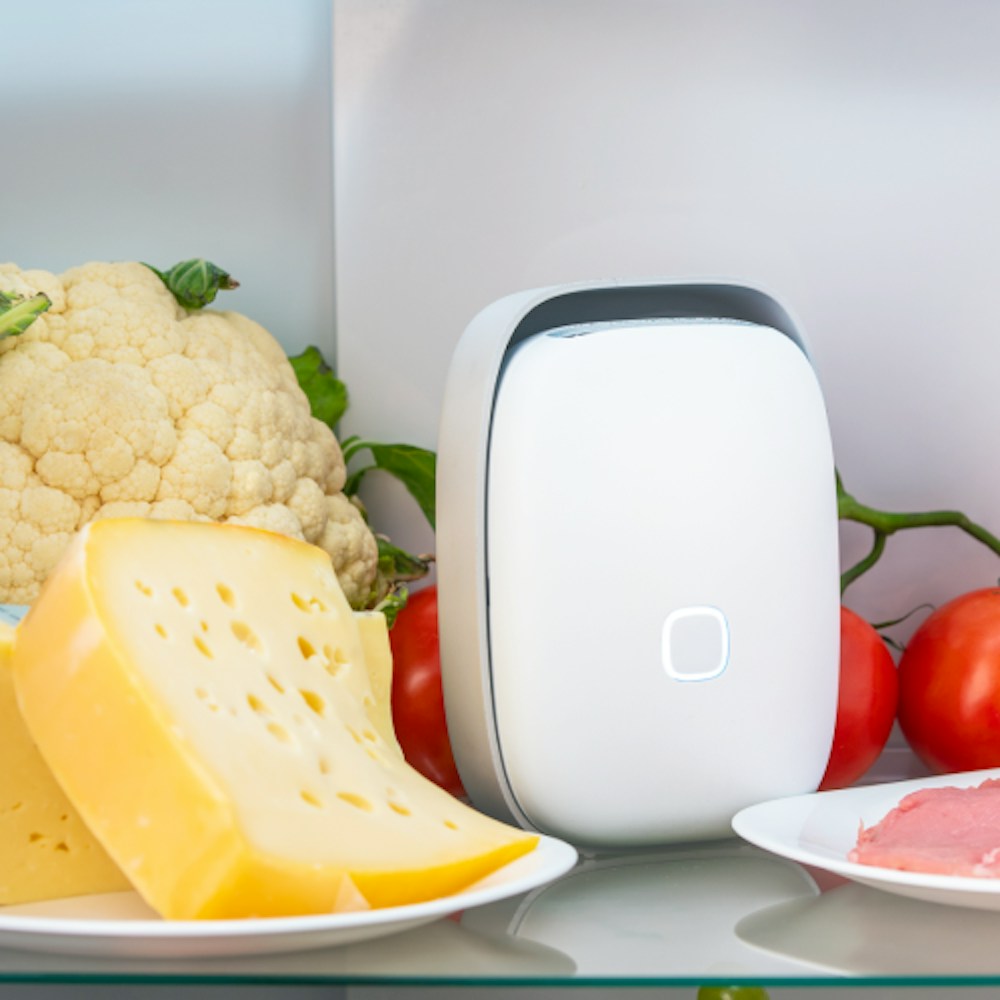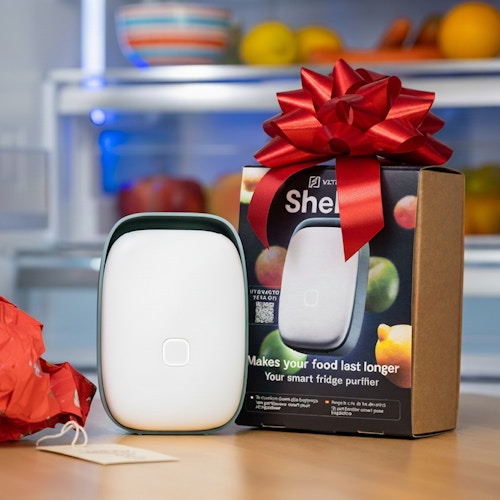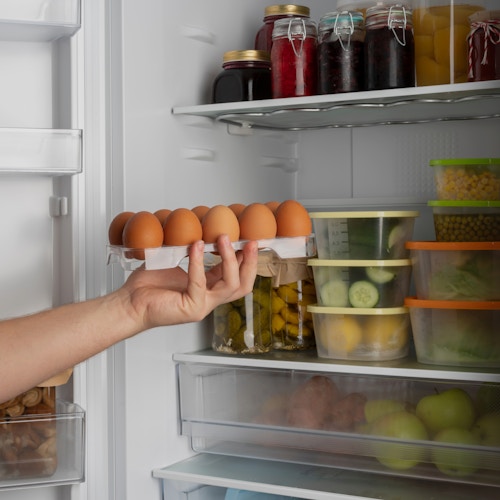
How to remove odors from your fridge with Shelfy
→
Baking soda, coffee, activated carbons… There are several methods to remove odors from the fridge, but there is one that is far more efficient than the others: Shelfy! Let’s find out why.
- What are odors?
- Why your fridge smells bad
- Why it's important to control temperature and humidity - Why conventional methods are not enough to remove odors
- Baking soda
- Activated carbon
- Ozone generator - The solution to remove odors: Shelfy by Vitesy
- How does Shelfy work?
What are odors?
Freshly baked bread, the aroma of coffee in the morning, flowers blooming during spring… They all have one thing in common: an amazing scent! All of these smells get through our noses and capture all of our senses, evoke memories and create new sensations. But what are odors?
Odors are molecules (chemical compounds) dispersed in the air that, when in contact with our olfactory system (our nose), can stimulate specialized cells found inside our nasal cavity called smell receptors. These receptors transmit the signals detected to our brain, which is able to interpret and discern them.
Why your fridge smells bad
There can be many sources of bad odors inside the fridge. The most obvious one is the presence of food that is going to waste, which releases volatile organic compounds in the air, spreading an unpleasant smell.
The process of decomposition occurs when bacteria and fungi are present and act on the food by degrading it and breaking it into molecules that can have an unpleasant smell, such as those based on nitrogen and sulfur. One example is trimethylamine, a compound made of nitrogen (chemical formula C3H9N) that is responsible for the pungent smell of fish, which gets stronger the more the produce remains in the household refrigerator. These compounds not only are the primary cause of unwanted odors, but also lead to odor cross-contamination, a process through which odors and scents that come from a certain food or from the substances inside the fridge move to other types of food or objects in their surrounding area. This contamination can have a significant impact on the quality of food and the overall sensorial experience by making food seem less appealing and negatively affecting its taste.

Another source of bad odors can be food that hasn’t been properly stored, for example without a container or a protective foil. This can happen with cured cheese, onions, salami and other types of foods that have a strong smell. Even leftovers from the night before need to be stored in containers that have a lid. This has to be done first of all for hygienic purposes and then because this way the smell will be released more slowly and won’t alter the properties of the food itself.
Why it's important to control temperature and humidity
Temperature and humidity inside the fridge play a crucial part in maintaining freshness and in preventing the formation of bad odors. This is how they work and why they are so important.
Low temperatures slow down the growth of bacteria and molds, which are the main culprits when it comes to the deterioration of food and the production of bad odors. For this reason, maintaining the fridge at a temperature that ranges from 4 to 6°C is essential to food preservation. Additionally, low and constant temperatures help prolong the quality of food, preventing it from deteriorating quickly. That’s why it is fundamental to correctly set the fridge thermostat and to not open its door constantly, so that there won’t be major temperature fluctuations which can also occur when the fridge is overfilled or contains warm or hot food.
An excess of humidity in the fridge can lead to condensation. Humidity creates an environment favorable to the growth of molds and bacteria, which can provoke bad odors and compromise food safety. That is why it is important to maintain a balanced humidity level to avoid these issues. Again, frequently opening the refrigerator or overfilling it, especially with warm or hot food, could be the cause of increased internal humidity.
Tip: to prevent condensation areas in the fridge, where odors can develop, it is recommended to avoid overfilling it. In fact, air should always circulate freely.

Why conventional methods are not enough to remove odors
To avoid unpleasant odors in the refrigerator, it is essential to store food properly and pay attention to its expiration date. Performing regular cleaning of the refrigerator approximately every 6 months is also very important, both to prevent the formation of microorganisms and odors and to maintain the appliance properly and make it stand the test of time. Check out our FAQ to learn the best way to clean your fridge!.
Popular home odor removal methods include odor absorbers, in particular baking soda and activated carbons. These can be placed on a small plate and positioned inside the fridge to absorb odors.
Baking soda
Baking soda is an alkaline substance that can neutralize acidic smells. In order for this method to work, the acidic molecules responsible for the smells have to aim for the small plate containing the baking soda and stick to it: the success rate is low because of the limited surface area of the baking soda. Moreover, not all odorous molecules are acidic, therefore the remedy’s effectiveness is questionable.
Activated carbon
A potentially better solution lies in activated carbon, also used for water purification, since its effectiveness does not depend on the acidic or alkaline characteristics of the molecules. Coffee grounds are also occasionally used, given the fact that they are rich in essential oils and other aromatic compounds and this creates a strong affinity with certain aromatic and volatile molecules. Even for coffee and activated carbon, the problem is that they only work over a limited area. They need to be replaced often to prevent them from releasing captured molecules and becoming a refuge for microorganisms.
Ozone generator
Another category of products widely used to get rid of odors are ozone generators. As the name suggests, these devices produce ozone, a compound with a pungent smell (some people describe it as garlicky) that possesses a high reactivity and breaks down and neutralizes odorous molecules when in contact with them, helping with the removal of bacteria and molds. Unfortunately, not everybody knows that ozone is a hazardous substance given its inherent physical, toxicological and ecotoxicological properties, typically incompatible with human presence. The danger mainly depends on concentration and time exposure. When in contact with food, ozone can cause oxidation reactions and alter taste and flavor. Additionally, its pungent smell can change the organoleptic properties of foods.
All of these methods have their strengths; however, there are some shortcomings that should not be overlooked. Odor absorbers are limited only to odor removal and thus have no effect whatsoever on the microorganisms inside the refrigerator, and if not changed periodically could themselves become a source of pollution in the refrigerator. Ozone generators, on the other hand, while effective on both odors and microorganisms, can be dangerous and alter the taste and quality of food.
Is there a solution with the right compromise? Of course there is!

The solution to remove odors: Shelfy by Vitesy
Shelfy is a fridge purifier that removes odors from the air and eliminates mold and bacteria, extending the shelf life of fresh food up to 12 days. Its filter is washable and reusable and its battery lasts up to 3 weeks: maintaining a device has never been easier! You can connect it via an app that helps you monitor door opening time and temperature. But let's take a step back.
How does Shelfy work?
The technology used by Shelfy is photocatalysis. The photocatalytic reaction occurs when the light from the LEDs on top of the ceramic filter hits it, removing pollutants in the air: therefore, not only it captures them but it acts at the level of chemical bonds. Specifically, chemical compounds are broken down into harmless molecules, while microorganisms (such as bacteria and molds) are rendered inactive. Thereby, photocatalysis is a harmless and sustainable technology that can eliminate odors from the refrigerator without compromising its organoleptic properties or emitting harmful substances into the air. All reactions occur on the filter and never act directly on the food, unlike ozone. The action of photocatalysis is broad-spectrum and does not act only on specific molecules, as in the case of coffee and baking soda. Thanks to its smart component, Shelfy helps you in being more conscious of your refrigerator use, allowing you to keep temperature and humidity under control, waste less, and pay attention to energy consumption.
And that’s not all! By removing ethylene molecules (the main responsible for the ripening of fruits and vegetables) from the air, Shelfy promotes the slowing of the ripening process by minimizing the spoilage of fruits and vegetables, consequently doubling the shelf life of these foods in the fridge!

Check out the Test Report to learn more about the effectiveness of Shelfy and the results of our tests performed at universities and independent laboratories.
Shelfy can be connected to the Vitesy Hub app, which allows you to monitor the door openings and the temperature, so you can check that your refrigerator is always in the optimal condition to best preserve your food. You will also get reminders to clean your fridge and filter! Don’t miss the “Food Library” section for tips on how to properly store various foods.
What are you waiting for? Join our fight against food waste and eat food that is always fresh and healthy thanks to Shelfy.




